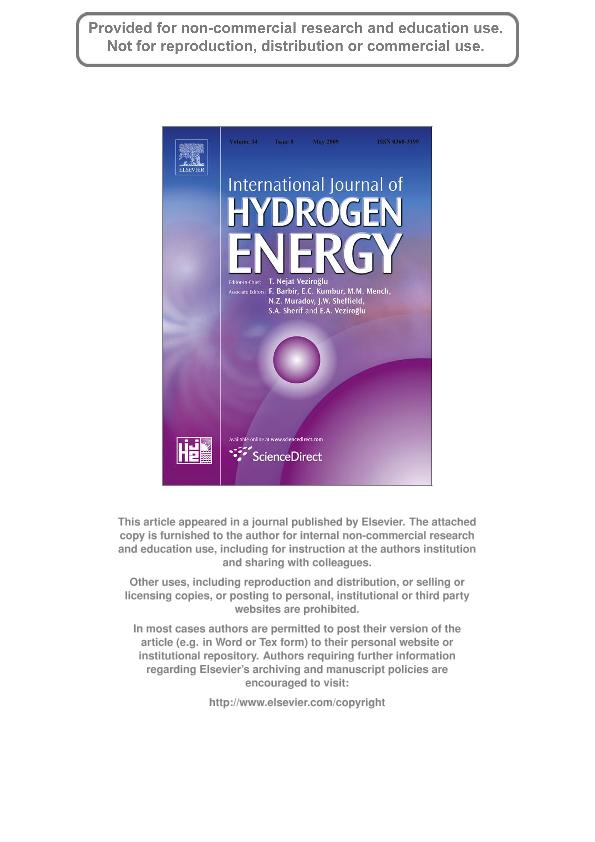Mostrar el registro sencillo del ítem
dc.contributor.author
Gesari, Susana Beatriz

dc.contributor.author
Pronsato, Maria Estela

dc.contributor.author
Juan, Alfredo

dc.date.available
2019-02-07T16:36:35Z
dc.date.issued
2009-05-16
dc.identifier.citation
Gesari, Susana Beatriz; Pronsato, Maria Estela; Juan, Alfredo; Simulation of hydrogen trapping at defects in Pd; Pergamon-Elsevier Science Ltd; International Journal of Hydrogen Energy; 34; 8; 16-5-2009; 3511-3518
dc.identifier.issn
0360-3199
dc.identifier.uri
http://hdl.handle.net/11336/69637
dc.description.abstract
The interaction of hydrogen with defects in palladium was studied using qualitative electronic structure calculations in the framework of the Atom Superposition and Electron Delocalization Molecular Orbital (ASED-MO) theory. Interatomic distances, energies and electronic structure for hydrogen at a dislocation and at a vacancy were determined and compared with that for an octahedral site in the Pd fcc lattice. We found that a repulsive H-H interaction is developed if these atoms occupy interstitial sites in a regular lattice. However, when the H atoms are close to a dislocation, the accumulation becomes possible. It was found that the dislocation allows hydrogen association at interatomic distances close to molecular hydrogen. The Density of States (DOS) and Crystal Orbital Overlap Population (COOP) curves were used to shed more light on the interstitial-Pd-defect interactions. Hydrogen produce changes in the local and global electronic structure of the host metal and induce changes in the cohesive forces between atoms in the host matrix. In all cases, it was found that strong bonds between Pd and H atoms are formed while metal-metal bonds are weakened. The metal-hydrogen bonds were characterized by charge transfer from metal atoms to hydrogen.
dc.format
application/pdf
dc.language.iso
eng
dc.publisher
Pergamon-Elsevier Science Ltd

dc.rights
info:eu-repo/semantics/openAccess
dc.rights.uri
https://creativecommons.org/licenses/by-nc-sa/2.5/ar/
dc.subject
Dislocation
dc.subject
Hydrogen
dc.subject
Palladium
dc.subject.classification
Física Atómica, Molecular y Química

dc.subject.classification
Ciencias Físicas

dc.subject.classification
CIENCIAS NATURALES Y EXACTAS

dc.title
Simulation of hydrogen trapping at defects in Pd
dc.type
info:eu-repo/semantics/article
dc.type
info:ar-repo/semantics/artículo
dc.type
info:eu-repo/semantics/publishedVersion
dc.date.updated
2019-01-23T19:10:18Z
dc.journal.volume
34
dc.journal.number
8
dc.journal.pagination
3511-3518
dc.journal.pais
Estados Unidos

dc.description.fil
Fil: Gesari, Susana Beatriz. Universidad Nacional del Sur. Departamento de Física; Argentina
dc.description.fil
Fil: Pronsato, Maria Estela. Consejo Nacional de Investigaciones Científicas y Técnicas. Centro Científico Tecnológico Conicet - Bahía Blanca. Instituto de Física del Sur. Universidad Nacional del Sur. Departamento de Física. Instituto de Física del Sur; Argentina
dc.description.fil
Fil: Juan, Alfredo. Consejo Nacional de Investigaciones Científicas y Técnicas. Centro Científico Tecnológico Conicet - Bahía Blanca. Instituto de Física del Sur. Universidad Nacional del Sur. Departamento de Física. Instituto de Física del Sur; Argentina
dc.journal.title
International Journal of Hydrogen Energy

dc.relation.alternativeid
info:eu-repo/semantics/altIdentifier/url/https://www.sciencedirect.com/science/article/pii/S0360319909002869
dc.relation.alternativeid
info:eu-repo/semantics/altIdentifier/doi/http://dx.doi.org/10.1016/j.ijhydene.2009.02.048
Archivos asociados
